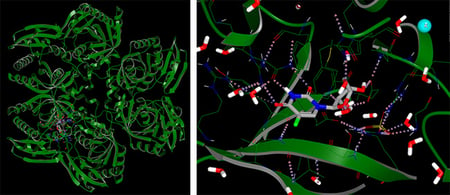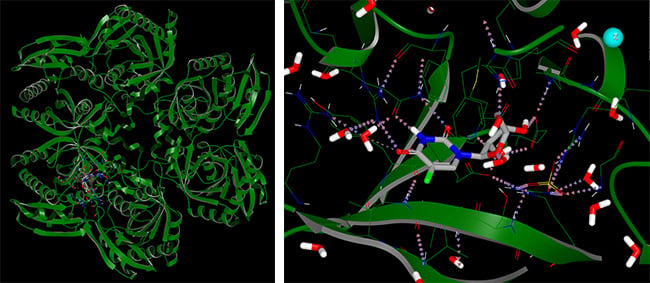OpenEye is pleased to announce the release of OpenEye Applications v2019.November. These applications include the usual support for Linux, macOS, and Windows.
HIGHLIGHTS
- SPRUCE, a new application for preparing biomolecular structures for modeling applications, is now available in the OpenEye applications bundle.
- SZMAP now provides a simpler but enhanced workflow, using the newly released SPRUCE technology for structure preparation.
- SMIRNOFF, a small molecule force field from the Open Force Field Initiative, is now integrated into SZYBKI.
SPRUCE: Application Suite for Biomolecular Structure Preparation
The 2019.Nov release introduces SPRUCE, which takes experimental biomolecular structure data in either PDB or mmCIF formats and prepares them for use with downstream modeling applications.
With SPRUCE, the output for the prepared proteins is a new OEDU (OpenEye Design Unit) file format. The prepared system is componentized into molecular categories, including protein, ligand, nucleic, solvent, and many other molecular types common to biomolecular experiments. By default, hydrogens are added to systems using a tautomer search for any ligand, cofactor, or other non-standard residue molecules. In addition, the system is split into distinct biological units and all final design unit structures are superposed into a common frame of reference.
The figures below show a prepared OEDU for a structure of E. coli Uridine Phosphorylase complexed with 5-Fluorouridine and sulfate (PDB code 1TGV). In the figure on the left the entire homo-pentamer is shown. The binding site residues and ligand atoms are shown explicitly with a wireframe representation to highlight the site of interest. Five OEDUs are generated for this PDB code, each OEDU focusing on one of the binding sites in the pentamer. The binding site view shows the ligand bound pose with OEInteractionHints highlighting various protein-ligand interactions.

A structure view (left) and binding site view (right) for E. coli Uridine Phosphorylase complexed with 5-Fluorouridine and sulfate (PDB: 1TGV) showing the protein, ligand, solvent, and counter ions near the binding site.
SPRUCE has been tested across a broad range of industry-relevant targets. It is built using the recently released Spruce TK, which has been used for virtual screening and molecular dynamics simulations in Orion, as well as to prepare structures for MMDS (MacroMolecular Data Service).
SZMAP: Simplified Workflow
SZMAP now provides a simpler but enhanced workflow, using the newly released SPRUCE technology for structure preparation. Structures prepared in the OEDU file format can be used as direct input to SZMAP or GamePlan without any further preparation steps.
The single utility application Spruce4Szmap replaces the three previous utility applications Pch, MKHetDict, and FixDupAtomNames. Spruce4Szmap also eliminates the need to use the external program reduce as part of the structure preparation workflow.
SZYBKI: SMIRNOFF
The 2019.Nov release incorporates the ability to use force fields based on SMIRNOFF (SMIRks Native Open Force Field) specifications into SZYBKI and FreeForm. Two such small molecule force fields, smirnoff99Frosst and OpenFF1.0.0, from the Open Force Field Initiative, have been incorporated in this release. Both the smirnoff99Frosst and OpenFF1.0.0 force fields can handle almost all pharmaceutically relevant chemical space.
The SMIRNOFF specification differs from traditional force field specifications principally in the data representation of the chemistry. It uses extended SMARTS strings for parameters instead of atom types, greatly reducing the number of interdependent parameters.
The Open Force Field Initiative is actively working on improvements to OpenFF1.0.0 and promises to bring newer force fields in the future. OpenEye plans to keep up to date with the latest versions of these force fields as they become available. A future release will incorporate the ability to use custom versions of SMIRNOFF force fields in SZYBKI.
GENERAL NOTICES
- Windows installation behavior has changed. Installation of OpenEye-applications bundle will now replace the previous version. See Installation for more information.
- All applications were ported to build using OEToolkits 2019.Oct. The previous versions were built using OEToolkits 2019.Apr.
PLATFORM SUPPORT
- RHEL6 is no longer supported.
- Windows 7 is no longer supported.
- RHEL8 is now partially supported (command line applications only). Qt applications will be included in future releases once Qt is supported on RHEL8
AVAILABILITY
OpenEye Applications v2019.Nov are now available for download. Existing licenses will continue to work, but if a new license is required, please contact your account manager or email sales@eyesopen.com.
Please see the Release Notes for full and specific details on improvements and fixes.
RESOURCES
About OpenEye Scientific
OpenEye Scientific is a privately held company headquartered in Santa Fe, New Mexico, with offices in Boston, Cologne, and Tokyo. It was founded in 1997 to develop large-scale molecular modeling applications and toolkits. Primarily aimed towards drug discovery and design, areas of application include:
- Cheminformatics
- Structure Generation
- Shape Comparison
- Docking
- Fragment Replacement
- Electrostatics
- Crystallography
- Visualization
The software is designed for scientific rigor as well as speed, scalability, and platform independence. OpenEye makes most of its technology available as toolkits—programming libraries suitable for custom development. OpenEye software typically is distributable across multiple processors and runs on Linux, Windows, and macOS.
For additional information
Jeffrey Grandy
Chief Commercial Officer
+1-415-863-3032
Email: sales@eyesopen.com

